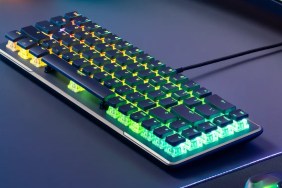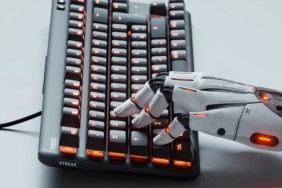Tilt by association.
Time was you knew an action character was good and dead when they were shunted into a pinball game. Last year we received ominous implications of Mario’s imminent demise when he got the treatment courtesy of Fuse Games. Now it’s Samus’ turn. Fuse has topped their last release, but Metroid Prime Pinball is still a far cry from the ideal pairing of Metroid and pinball wizardry.
And why not put the morphed-up warrior into the sort of game a dinosaur rock band could wax poetic about? We spend so much Metroid time rolled up into a ball that it should be a perfect fit. As the name implies, the game draws inspiration from the series’ 2002 Gamecube revival, but there’s a healthy dose of uniquely DS tech on hand to set this Metroid apart.
 The pinball gameplay is split between the top and bottom screens. The division works surprisingly well, since a bit of dead space has been programmed into the inch of plastic between screens. That means the ball doesn’t instantaneously leave one screen and appear on the other, giving your eye time to make the leap. It’s weird at first, but the gap quickly becomes as natural as it could be.
The pinball gameplay is split between the top and bottom screens. The division works surprisingly well, since a bit of dead space has been programmed into the inch of plastic between screens. That means the ball doesn’t instantaneously leave one screen and appear on the other, giving your eye time to make the leap. It’s weird at first, but the gap quickly becomes as natural as it could be.
The tables themselves are based on familiar Metroid levels like the Pirate Frigate and Phaezon Mines. New boards are unlocked through the Multi-Mission mode, but there are only six in total, four of which barely even qualify. Cue cartoon double take – six single-player tables? That’s just absurd, especially since no single one features a classic pinball layout that could be played on your lunch break.
That’s mainly because most of the boards spend too much time trying to replicate Metroid to actually provide a good game of pinball. The four tables that ‘barely qualify’ are essentially boss battles. When first unlocked in Multi-Mission mode, they’re fun and even challenging, requiring you to repeatedly smack poor Samus into, say, the Omega Pirate. Upon completion, they’re available for free play in what amounts to a time attack challenge. But the goal is the same – beat the boss. I’d be hard-pressed to play the fights from Shadow of the Colossus a hundred times, and those are the freakin’ sweetest boss battles ever. These aren’t even close.
 That leaves two boards (incidentally, the first unlocked) to shoulder proper pinball gameplay. The kicker is they’re almost great at it. The actual ball physics and pinball mechanics are excellent. The flippers are responsive, the ball is dynamic and some good imagination has gone into tweaking classic modes like multi-ball. In particular, the Pirate Frigate features a collection of ramps and chutes that, if expanded and made more complex, would start looking like a great table. Only the tilt function, which is the lone use of the touch screen, is implemented with less than stellar results.
That leaves two boards (incidentally, the first unlocked) to shoulder proper pinball gameplay. The kicker is they’re almost great at it. The actual ball physics and pinball mechanics are excellent. The flippers are responsive, the ball is dynamic and some good imagination has gone into tweaking classic modes like multi-ball. In particular, the Pirate Frigate features a collection of ramps and chutes that, if expanded and made more complex, would start looking like a great table. Only the tilt function, which is the lone use of the touch screen, is implemented with less than stellar results.
In addition to performing well with the flippers, players have to unlock artifacts by activating and winning mini-games. One contest sees Samus unfurl into human form in order to blow away a bunch of Shriekbats. (Not Shriekbacks.) Another unleashes a few Triclops, which can be battered or bombed. The Metroid show up, too, deviling players down near the flippers.
Free of any context, these mini-games are decent fun. They’re on a time limit, so none can totally overtake play, and many actually rely on basic pinball skills. But they offer the same actions on both boards and instead of becoming subtly challenging, they eventually just overwhelm players with enemies, hoping that Samus has grabbed a few missiles here and there.
With so much energy devoted to mini-games, it feels like there’s little else to do. None of the tables manage to present a tough enough pinball challenge alone. Pinball’s classic blend of simplicity and difficulty awards the game a longevity that has kept it popular for decades. That balance is way off here.
 You can’t fault the delivery, though. The game looks and sounds so good – it really is beautiful – that almost anyone who picks it up will immediately want to play through a couple boards, but the attraction wears thin just as quickly.
You can’t fault the delivery, though. The game looks and sounds so good – it really is beautiful – that almost anyone who picks it up will immediately want to play through a couple boards, but the attraction wears thin just as quickly.
Metroid Prime Pinball also features an eight-player wireless mode, in which a single DS can deliver a table to other players. Unfortunately, there’s only a single board to play on, and it’s not the most challenging of the bunch. Players compete for a point total, which really doesn’t take very long once they get the hang of the board. Still, the ability to play wirelessly with only one cartridge is hard to knock.
It seems like there was something else” another point buzzing at the back of my mind. Wait, that’s not a talking point – it’s the included rumble pak, which beeps and chirps more than it rumbles and is often louder than the game’s effects. Nothing wrong with a little vibration in our pseudo-pinball, but if the rumble pack weren’t included we’d look askance at anyone who paid for the accessory separately.
Don’t be distracted by presentation. ‘Best-looking’ doesn’t necessarily mean best, and there’s nowhere near enough gameplay here to keep Metroid Prime Pinball lodged in your DS for long. A single super-addictive board would have done it, but instead we get an assortment of boss fights, a plethora of mini-games and just too few solid actual pinball tables. Next time, hopefully Fuse will go easier on the mini-games. We’d rather have a character-based game that’s great at pinball rather than a fence-riding jack of all trades that is master of none.
-
It shore is purty
-
Excellent physics
-
Boss battles are fun the first time
-
And lame the 21st time
-
Mini-game O.D.
-
Needs more tables











